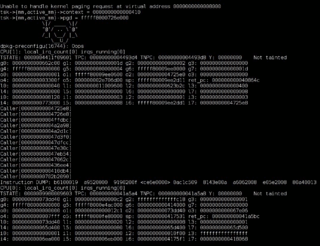In Linux, the System.map file is a symbol table used by the kernel.
A symbol table is a look-up between symbol names and their addresses in memory. A symbol name may be the name of a variable or the name of a function. The System.map is required when the address of a symbol name, or the symbol name of an address, is needed. It is especially useful for debugging kernel panics and kernel oopses. The kernel does the address-to-name translation itself when CONFIG_KALLSYMS is enabled so that tools like ksymoops are not required. [1]
The following is part of a System.map file: [2]
c041bc90 b packet_sklist c041bc94 b packet_sklist_lock c041bc94 b packet_socks_nr c041bc98 A __bss_stop c041bc98 A _end c041c000 A pg0 ffffe400 A __kernel_vsyscall ffffe410 A SYSENTER_RETURN ffffe420 A __kernel_sigreturn ffffe440 A __kernel_rt_sigreturn
Because addresses may change from one build to the next, a new System.map is generated for each build of the kernel. [3]
The character between the address and the symbol (separated by spaces) is the type of a symbol. The nm utility program on Unix systems lists the symbols from object files. The System.map is directly related to it, in that this file is produced by nm on the whole kernel program – just like nm lists the symbols and their types for any small object programs. [4]
Some of these types are: [4]
A for absoluteB or b for uninitialized data section (called BSS)D or d for initialized data sectionG or g for initialized data section for small objects (global)i for sections specific to DLLsN for debugging symbolp for stack unwind sectionR or r for read only data sectionS or s for uninitialized data section for small objectsT or t for text (code) sectionU for undefinedV or v for weak objectW or w for weak objects which have not been tagged so- for stabs symbol in an a.out object file? for "symbol type unknown"After building the Linux kernel, System.map is located in the root of the source directory. However, some further software installation steps expect to locate the file elsewhere: [5]
In computing, a segmentation fault or access violation is a fault, or failure condition, raised by hardware with memory protection, notifying an operating system (OS) the software has attempted to access a restricted area of memory. On standard x86 computers, this is a form of general protection fault. The operating system kernel will, in response, usually perform some corrective action, generally passing the fault on to the offending process by sending the process a signal. Processes can in some cases install a custom signal handler, allowing them to recover on their own, but otherwise the OS default signal handler is used, generally causing abnormal termination of the process, and sometimes a core dump.
XFS is a high-performance 64-bit journaling file system created by Silicon Graphics, Inc (SGI) in 1993. It was the default file system in SGI's IRIX operating system starting with its version 5.3. XFS was ported to the Linux kernel in 2001; as of June 2014, XFS is supported by most Linux distributions; Red Hat Enterprise Linux uses it as its default file system.
In computing, a core dump, memory dump, crash dump, storage dump, system dump, or ABEND dump consists of the recorded state of the working memory of a computer program at a specific time, generally when the program has crashed or otherwise terminated abnormally. In practice, other key pieces of program state are usually dumped at the same time, including the processor registers, which may include the program counter and stack pointer, memory management information, and other processor and operating system flags and information. A snapshot dump is a memory dump requested by the computer operator or by the running program, after which the program is able to continue. Core dumps are often used to assist in diagnosing and debugging errors in computer programs.

The Netwide Assembler (NASM) is an assembler and disassembler for the Intel x86 architecture. It can be used to write 16-bit, 32-bit (IA-32) and 64-bit (x86-64) programs. It is considered one of the most popular assemblers for Linux and x86 chips.
A modern computer operating system usually segregates virtual memory into user space and kernel space. Primarily, this separation serves to provide memory protection and hardware protection from malicious or errant software behaviour.

A kernel panic is a safety measure taken by an operating system's kernel upon detecting an internal fatal error in which either it is unable to safely recover or continuing to run the system would have a higher risk of major data loss. The term is largely specific to Unix and Unix-like systems. The equivalent on Microsoft Windows operating systems is a stop error, often called a "blue screen of death".
The Common Object File Format (COFF) is a format for executable, object code, and shared library computer files used on Unix systems. It was introduced in Unix System V, replaced the previously used a.out format, and formed the basis for extended specifications such as XCOFF and ECOFF, before being largely replaced by ELF, introduced with SVR4. COFF and its variants continue to be used on some Unix-like systems, on Microsoft Windows, in UEFI environments and in some embedded development systems.
An object file is a computer file containing object code, that is, machine code output of an assembler or compiler. The object code is usually relocatable, and not usually directly executable. There are various formats for object files, and the same machine code can be packaged in different object file formats. An object file may also work like a shared library.
In computer programming, a magic number is any of the following:
In computing, a loadable kernel module (LKM) is an object file that contains code to extend the running kernel, or so-called base kernel, of an operating system. LKMs are typically used to add support for new hardware and/or filesystems, or for adding system calls. When the functionality provided by an LKM is no longer required, it can be unloaded in order to free memory and other resources.
In computer science, a symbol table is a data structure used by a language translator such as a compiler or interpreter, where each identifier, constant, procedure and function in a program's source code is associated with information relating to its declaration or appearance in the source. In other words, the entries of a symbol table store the information related to the entry's corresponding symbol.
Nucleus RTOS is a real-time operating system (RTOS) produced by the Embedded Software Division of Mentor Graphics, a Siemens Business, supporting 32- and 64-bit embedded system platforms. The operating system (OS) is designed for real-time embedded systems for medical, industrial, consumer, aerospace, and Internet of things (IoT) uses. Nucleus was released first in 1993. The latest version is 3.x, and includes features such as power management, process model, 64-bit support, safety certification, and support for heterogeneous computing multi-core system on a chip (SOCs) processors.

vmlinux is a statically linked executable file that contains the Linux kernel in one of the object file formats supported by Linux, which includes Executable and Linkable Format (ELF) and Common Object File Format (COFF). The vmlinux file might be required for kernel debugging, symbol table generation or other operations, but must be made bootable before being used as an operating system kernel by adding a multiboot header, bootsector and setup routines.
In computing, a data segment is a portion of an object file or the corresponding address space of a program that contains initialized static variables, that is, global variables and static local variables. The size of this segment is determined by the size of the values in the program's source code, and does not change at run time.
In computer programming, the block starting symbol is the portion of an object file, executable, or assembly language code that contains statically allocated variables that are declared but have not been assigned a value yet. It is often referred to as the "bss section" or "bss segment".

In computing, an oops is a serious but non-fatal error in the Linux kernel. An oops may precede a kernel panic, but it may also allow continued operation with compromised reliability. The term does not stand for anything, other than that it is a simple mistake.

The GNU Binary Utilities, or binutils, are a set of programming tools for creating and managing binary programs, object files, libraries, profile data, and assembly source code.
Cryptoloop is a Linux kernel's disk encryption module that relies on the Crypto API, which is a cryptography framework introduced in version 2.5.45 of the Linux kernel mainline. Cryptoloop was first introduced in the 2.5.x kernel series; its functionality was later incorporated into the device mapper, a generic framework used to map one block device onto another.

In computing, a screen of death, colloquially referred to as a blue screen of death, is an informal term for a type of a computer operating system error message displayed onscreen when the system has experienced a fatal system error. The fatal error typically results in unsaved work being lost and often indicates serious problems with the system's hardware or software. These error screens are usually the result of a kernel panic, although the terms are frequently used interchangeably. Most screens of death are displayed on an even background color with a message advising the user to restart the computer.
Memory footprint refers to the amount of main memory that a program uses or references while running.